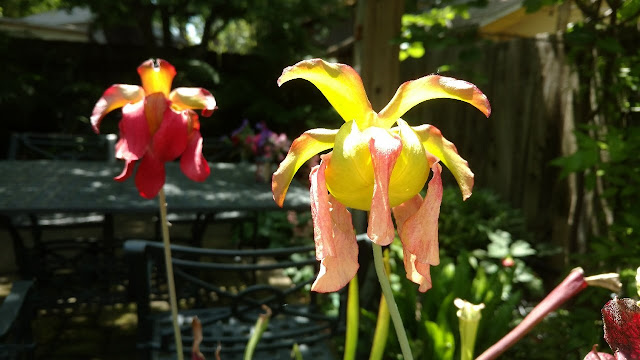
Sacramento Bromeliad and Carnivorous Plant Society hosts 52nd annual show and sale

|
|
Pitcher plants are among the carnivorous plants that do well outdoors in
the Sacramento area. See more plants at the show and sale this weekend. (Photo:
Debbie Arrington)
|
In most gardens, bugs eat plants. But these plants eat bugs.
Discover the fascinating world of carnivorous plants during the 52nd annual Sacramento Bromeliad and Carnivorous Plant Society Show and Sale, set for this Saturday and Sunday, June 18 and 19, at Shepard Garden and Arts Center.
See hundreds of intriguing specimens, with several species that are right at home in Sacramento. Pitcher plants, for example, can be grown outdoors in our area. They do particularly well as part of a backyard water feature such as a half wine barrel or small pond; their roots get the boggy conditions they prefer while the plants have access to insects that may fly by.
Because they evolved to grow in such poor soil, carnivorous plants get most of their nourishment from insects that can become trapped in their specialized (often sticky) foliage. Likewise, bromeliads trap moisture and nutrients in the center of their swirl of colorful foliage.
Club members will be on hand to answer questions and offer advice. An excellent selection of plants will be offered for sale. Find pitcher plants, sundews, butterworts and other bug eaters as well as tillandsia (air plants) and bromeliads in a rainbow of hues.
Hours are 9 a.m. to 4 p.m. Saturday and Sunday. Admission and parking are free.
Shepard Center is located at 3330 McKinley Blvd., Sacramento, in McKinley Park.
Details and directions: www.sgaac.org .
Comments
0 comments have been posted.Sacramento Digs Gardening to your inbox.
Food in My Back Yard Series
April 29: What's (already) wrong with my tomato plants?
April 22: Should you stock up on fertilizer? (Yes!)
April 15: Grow culinary herbs in containers
April 8: When to plant summer vegetables
April 1: Don't be fooled by these garden myths
March 25: Fertilizer tips: How to 'feed' your vegetables for healthy growth
March 18: Time to give vegetable seedlings some more space
March 11: Ways to win the fight against weeds
March 4: Potatoes from the garden
Feb. 25: Plant a fruit tree now -- for later
Feb. 18: How to squeeze more food into less space
Feb. 11: When to plant? Consider staggering your transplants
Feb. 4: Starting in seed starting
Sites We Like
Garden Checklist for week of May 4
Enjoy this spring weather – and get gardening!
* Plant, plant, plant! It’s prime planting season in the Sacramento area. Time to set out those tomato transplants along with peppers and eggplants. Pinch off any flowers on new transplants to make them concentrate on establishing roots instead of setting premature fruit.
* Direct-seed melons, cucumbers, summer squash, corn, radishes, pumpkins and annual herbs such as basil.
* Harvest cabbage, lettuce, peas and green onions.
* In the flower garden, direct-seed sunflowers, cosmos, salvia, zinnias, marigolds, celosia and asters. (You also can transplant seedlings for many of the same flowers.)
* Plant dahlia tubers. Other perennials to set out include verbena, coreopsis, coneflower and astilbe.
* Transplant petunias, marigolds and perennial flowers such as astilbe, columbine, coneflowers, coreopsis, dahlias, rudbeckia and verbena.
* Keep an eye out for slugs, snails, earwigs and aphids that want to dine on tender new growth.
* Feed summer bloomers with a balanced fertilizer.
* For continued bloom, cut off spent flowers on roses as well as other flowering plants.
* Add mulch to the garden to maintain moisture. Mulch also cuts down on weeds. But don’t let it mound around the stems or trunks of trees or shrubs. Leave about a 6-inch to 1-foot circle to avoid crown rot or other problems.